The HubSpot Blog’s 2023 Social Media Marketing Report: Data from 1200+ Global Marketers
Let’s face it – social media marketing in 2023 is harder than ever.
Making good content isn’t even half the battle for brands today. Marketers also need to share it across a bunch of different apps and tweak it to fit the aesthetic and tone of each platform.
With social media and the marketers who use it moving at the speed of light, keeping up with new platforms, trends, and algorithm updates isn’t easy.
To help you stay ahead of the game, we asked 1,283 social media marketers around the globe about the biggest trends they’re seeing, their goals, challenges, and strategies going into 2023.
Not much time on your hands? Click the section you’d like to jump to here:
- Social Media Trends
- Top Social Media Platforms
- Social Media Content Trends
- Top Social Media Marketing Goals
- The Top Social Media Challenges
- Top Social Media Marketing Metrics
- The Best Times to Post on Social Media
- Social Media Marketer Predictions
1. Brands with an engaged social media community will win audiences.
Community is key to connecting and engaging with your audience on social.
The biggest change social media marketers have seen in the past year is the growing importance of building active social communities. In fact, 90% of them say building an active online community is crucial to a successful social media strategy in 2023.
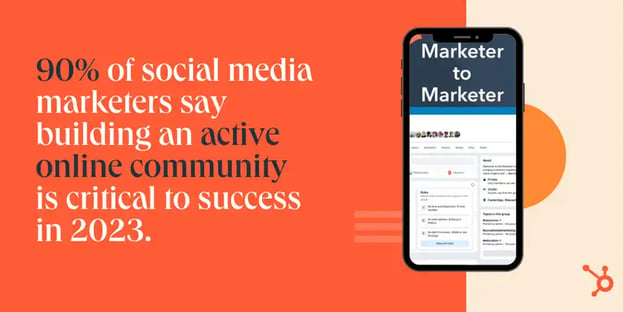
Our consumer trends survey also backs this up — 20% of social media users joined an online community in the past three months, and 22% actively participated in one.
So where should you be building these communities? Facebook and Instagram are the most effective platforms for community building overall, but TikTok would be best for a Gen Z audience. At the end of the day, it all depends on the demographic you’re targeting
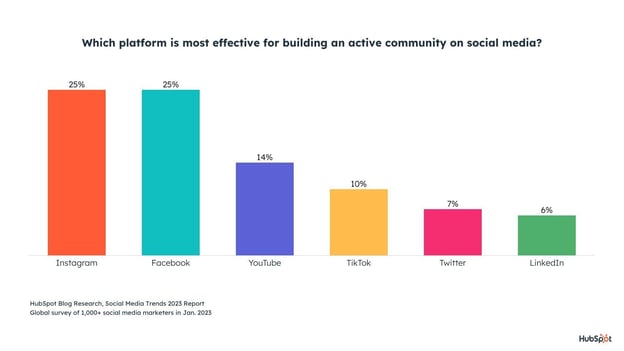
2. Social media could be the future of e-commerce.
Over the course of 2022, social media apps evolved into e-commerce platforms that connect users with products they can buy without leaving the app.
While some, like Instagram, are further along in this transformation, the rest are working hard to implement new features and tools that enable social shopping.
So, how’s it going so far? Currently, 47% of social media marketers say their brand sells directly within social media apps.
But what’s more important is that consumers are discovering new products on social media more than anywhere else.
Social media takes the lead for product discovery among Gen Z, Millennials, and Gen X, beating out internet search. Social is also the channel consumers 18-54 most prefer to discover new products on.
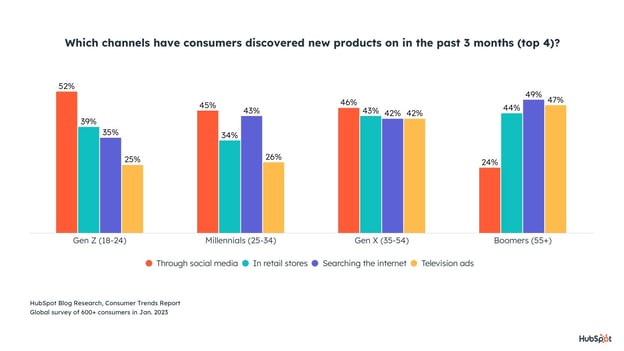
When it comes to actually buying products on social media, over one in five Gen Z, Millennial, and Gen X social media users have made an in-app purchase in the past three months.
This all sounds great, but social selling still faces a serious challenge — trust.
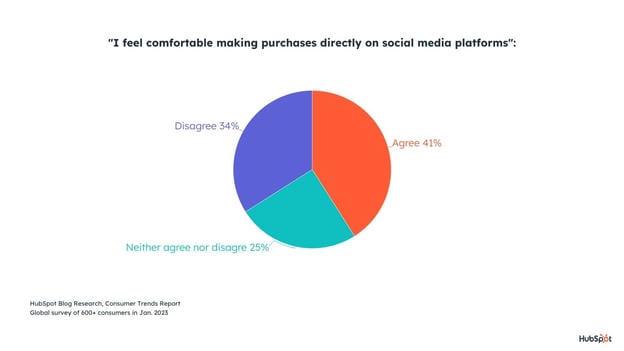
Just 41% of social media users feel comfortable making purchases on social media platforms and only 37% trust social media platforms with their card information.
The three biggest concerns social media users have when it comes to making purchases on social platforms are that the companies aren’t legitimate (54%), that they won’t be able to get a refund (48%), and concerns about the quality of the products being sold (44%).
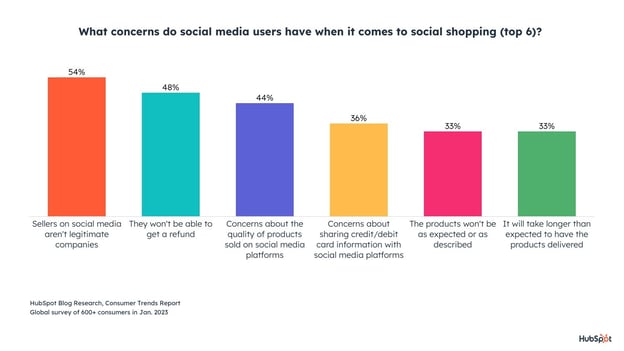
If you’re ready to dive into social selling, marketers say Instagram offers the most ROI and best tools, while consumers say it has the best in-app shopping experience of any app – though that could change in 2023.
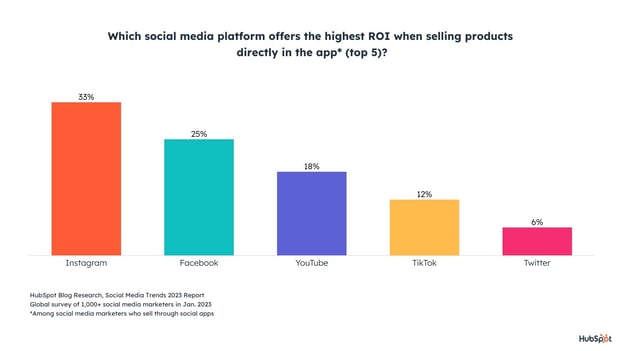
With each app offering multiple ways to sell, you may be wondering which features are used most. The most popular selling feature is Instagram Shops, used by 22% of social media marketers, followed by Facebook Shops (21%), and Instagram Live Shopping (19%).
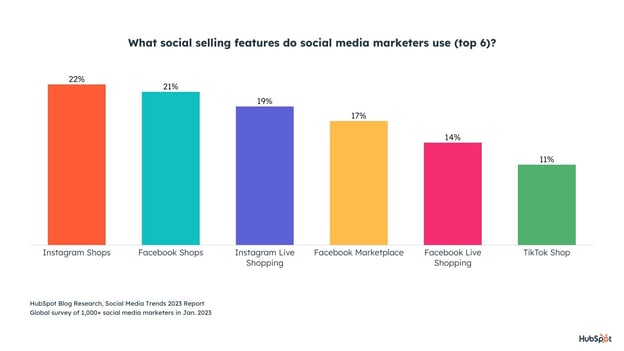
3. Consumers slide into brands’ DMs for customer service.
Since social media is all about shopping, it makes sense that customer service is moving into the DMs.
Around one in five Gen Z, Millennial, and Gen X social media users have contacted a brand through DMs for customer service in the past 3 months, and 76% of social media marketers say their company already offers customer service on social.
But whose job is it to respond?
43% of companies offering customer service through DMs have a customer service rep responding to messages, while 41% leave it up to the marketer in charge of managing that platform. Another 13% use automated tools like chatbots, which I expect to become more popular this year.
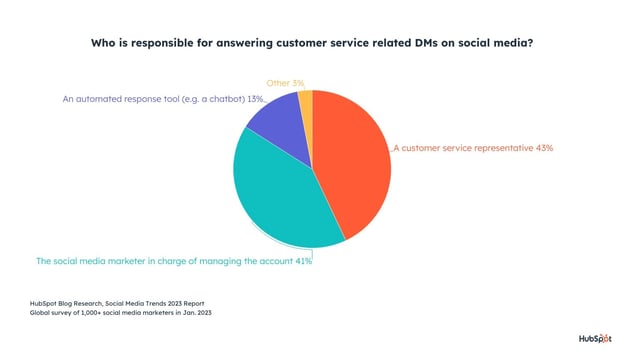
4. Consumers are turning to social in place of Google.
There’s a lot of hype right now about how AI and social search will make Google and other search engines obsolete. While it’s a bit soon to make that claim, social search is definitely taking off in 2023.
24% of consumers 18-54 already search for brands on social media more often than through a search engine – and this jumps up to 36% among Gen Z.
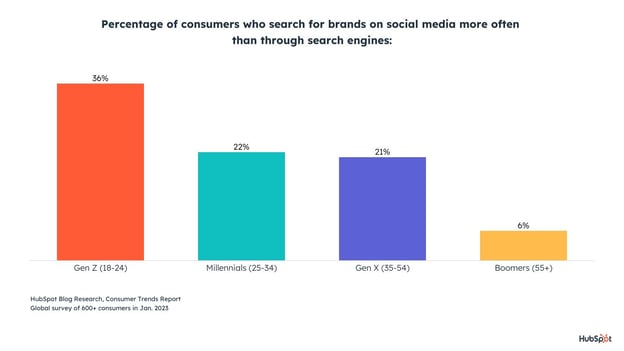
55% of social media users in our survey use social search so let’s take a look at what they’re searching for. People, content, brands, inspiration, and products/services to buy are the top uses of social search – pretty much all the same stuff we use search engines for.
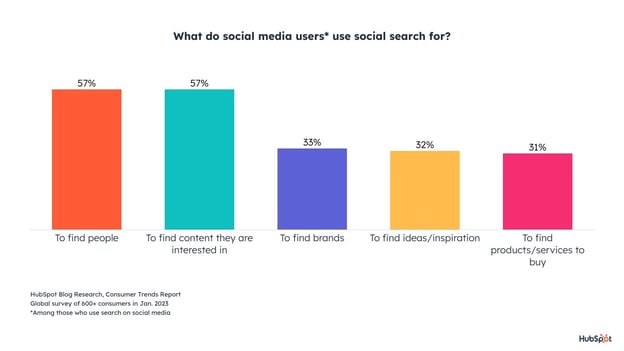
So, how can you optimize your social media accounts for social search? According to social media marketers who do it, the top strategies are including relevant keywords and hashtags in your posts and bio, making sure your username is easy to search for, and making sure your username is consistent across accounts.
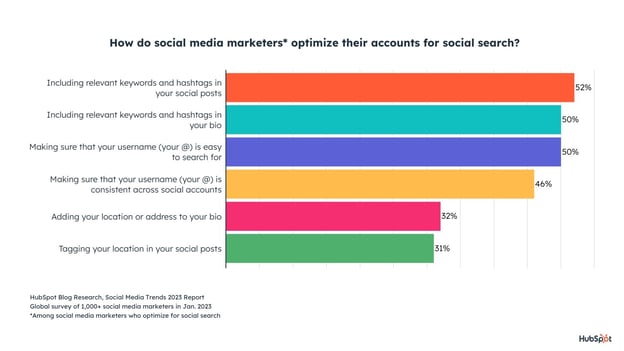
89% of social media marketers say social search is important to their overall social strategy, and they rate Instagram, Facebook, and YouTube are the platforms with the best search capabilities.
5. Brands swap out celebrities for micro-influencers.
Influencer marketing continues to be one of the most effective strategies for social media marketers in 2023, but we’ve seen a new approach gain popularity.
80% of influencer marketers work with smaller creators/influencers with under 100K followers and just 16% work with celebrities who have over a million followers.
Compared to celebrities, working with small influencers is less expensive, makes it easier to establish long-term partnerships, and offers access to tight-knit, engaged, and loyal communities.
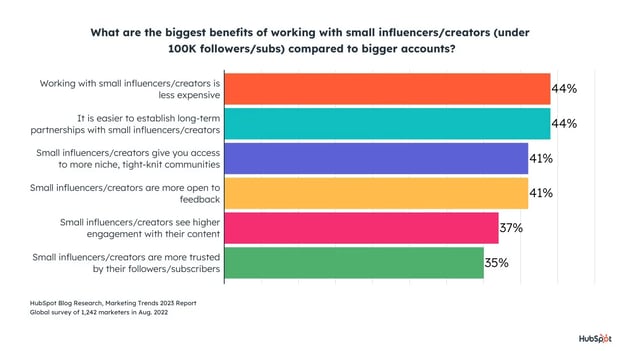
And when it comes to how influencer marketers decide which influencers/creators to partner with, they say quality of the content is more important than how many followers influencers have. Alignment with brand values also plays a major role.
Regardless of how big or small the influencer is, influencer marketing is a highly effective marketing channel that drives consumer purchase decisions.
Our consumer trends survey shows that 31% of social media users prefer to discover new products on social media through an influencer they follow over any other social format or channel. This shoots up to 43% for Gen Z – making influencer marketing their preferred product discovery channel.
On top of that, 21% of social media users 18-54 have made a purchase based on an influencer’s recommendation in the past 3 months. This also rises to 32% among Gen Z.
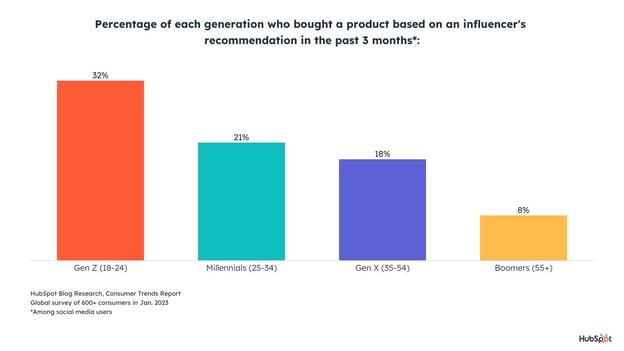
Social media marketers are also betting big on influencer marketing in 2023. 81% predict that most companies will have a creator/influencer as the face of their brand in 2023, and 47% are increasing their investment, while another 41% will keep it the same.
Influencer marketers work with influencers/creators in fashion (41%) the most, followed by lifestyle/vlog (40%), fitness/health (37%), food (34%), travel (33%), and family (33%).
As far as platforms, influencer marketers see the highest ROI through Instagram, with YouTube and Facebook tied for #2. These are also the 3 most popular platforms for influencer marketing.
The main goals influencer marketers set when running campaigns center around increasing brand awareness, growing their audience, and of course, boosting sales.
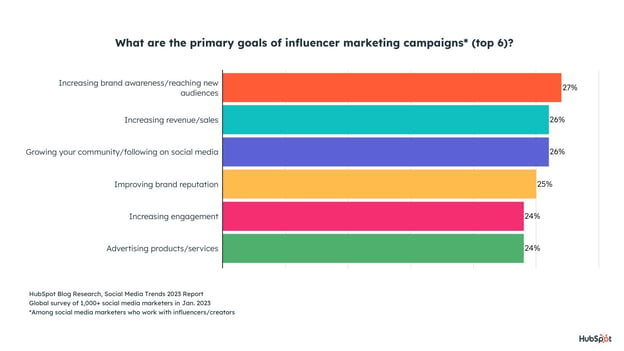
Brand awareness and sales are also the top two metrics influencer marketers track to measure the effectiveness of their campaigns, followed by views and engagement.
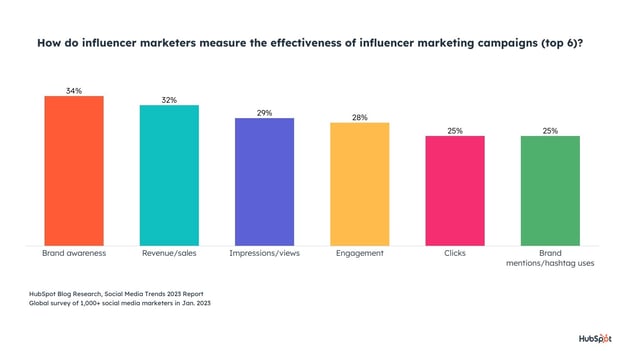
While influencer marketing is powerful, it also has a few key challenges. The biggest challenges include keeping up with trends, the cost of working with influencers, building a creative strategy, measuring ROI, and finding time to manage campaigns.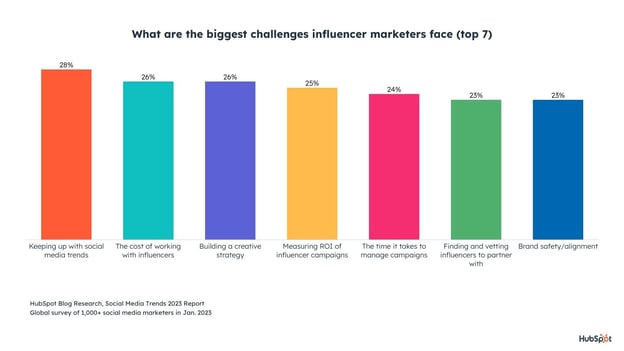
Influencer marketers also struggle with finding and vetting influencers who are aligned with their brand.
That makes sense considering 55% of influencer marketers find creators by tracking them down themselves on social media. 47% use an agency to match them with the right influencers while 44% make use of an online platform.
Now that we’ve gone over the top 5 trends, let’s take a deeper dive into the rest starting with the platforms marketers are using the most, which offer the best ROI, and the social apps you can expect to grow the most in 2023.
6. Brands will flock to Instagram for ROI and audience growth.
Instagram is used by 65% of social media marketers, coming in just behind Facebook at 67%.
The good news for Instagram marketers is the platform takes the top spot for ROI, engagement, and biggest potential growth in 2023.
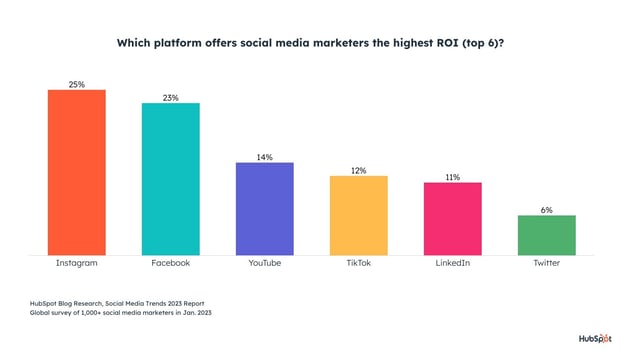
29% of social media marketers plan to invest the most in Instagram over any other platform and 52% plan to increase their investment in the platform in 2023, while another 39% will keep it the same.
Instagram will grow from first-time users too, with 36% of social media marketers not using it yet planning to try it out in 2023.
If that isn’t enough, Instagram is the app social media marketers expect to grow the most in 2023, has the most accurate algorithm, and offers brands the best potential to grow their audience.
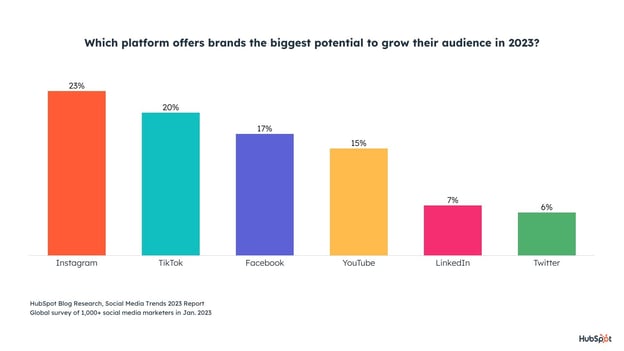
It’s also important to note that social media apps are transitioning into e-commerce platforms, and Instagram is leading the charge. We’ll take a deep dive the social selling trend later, but part of Instagram’s advantage right now could be due to the fact that it has the most developed in-app selling tools of any platform.
Before moving on to trend #7, let’s take a look at a few more social media platforms and see how they stack up against each other.
Facebook will keep growing, but TikTok’s closing in.
Facebook might be the platform used by most social media marketers at 67%, but it takes the #2 spot behind Instagram for engagement and ROI.
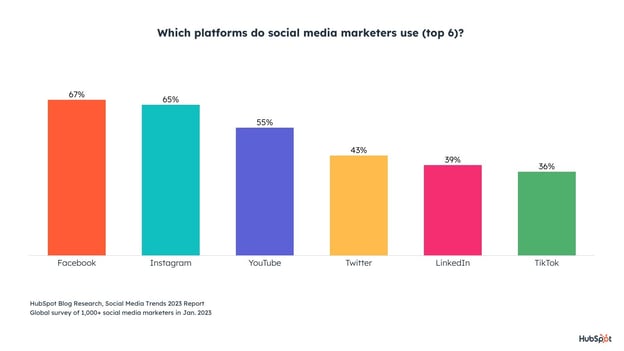
Facebook will also see significant growth in 2023, with 23% of social media marketers planning to invest more in it than any other platform, and 43% plan to increase their investment in Facebook, while 41% will continue investing the same amount.
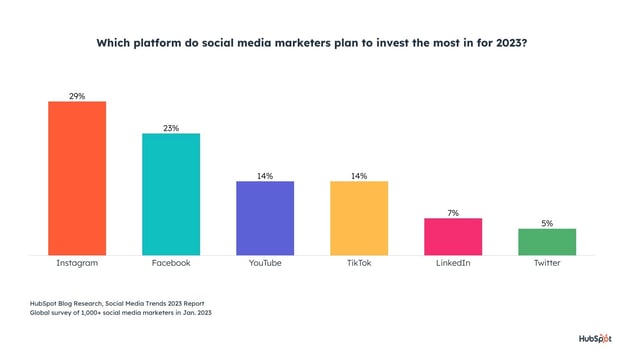
Despite that, social media marketers see Facebook in third behind both Instagram and TikTok when it comes to the platform with the highest potential to grow in 2023. They also think TikTok is a better bet for brands to grow their audience.
TikTok Usage Lags Despite Popularity Among Gen Z, and Growth Potential
With all the hype around TikTok, you’d think social media marketers are flocking to it en masse, but the reality is that just 36% use it.
That isn’t too surprising as it’s one of the newest platforms on the block, but it begs the question of whether marketers are sleeping on a great opportunity.
The key factor is who your marketing efforts target – 73% of Gen Z uses TikTok according to our consumer trends survey. While it’s true a higher percentage of Gen Z (85%) use Instagram, TikTok is the platform Gen Z spends the most time on.
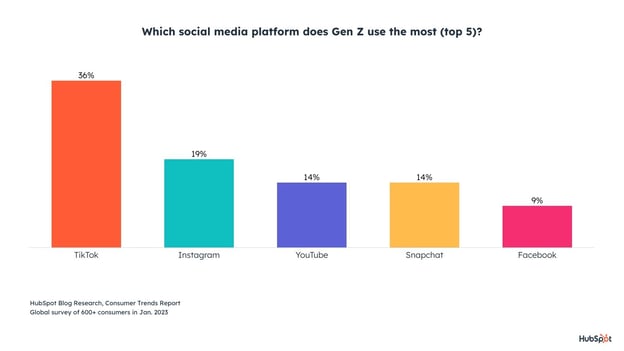
.
The social media marketers using TikTok are doubling down on their investment in 2023 – more than marketers on any other platform. 53% of them will increase their investment in marketing on TikTok in 2023 and another 36% will keep investing the same amount.
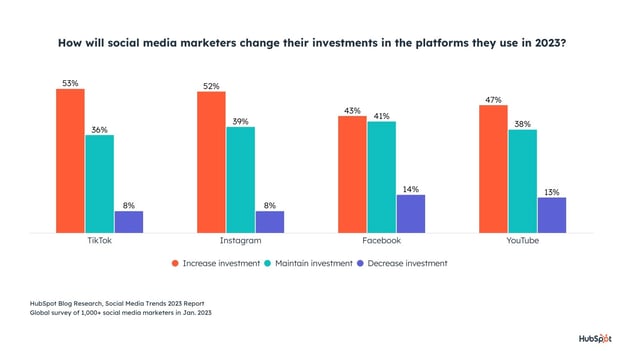
20% of social media marketers also think TikTok as a platform has more potential for growth than any other, only behind Instagram at 22%. 1 in 4 also say TikTok offers brands the biggest potential to grow their audience of any platform, once again behind Instagram which takes the top spot.
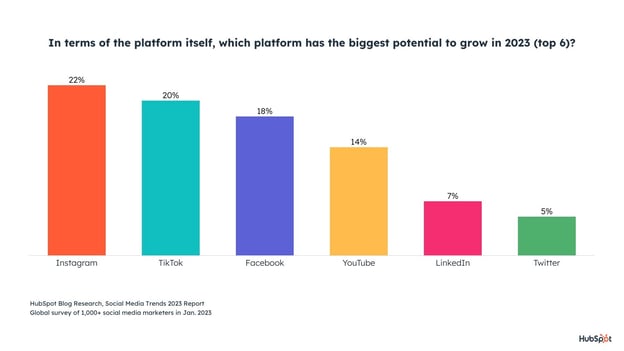
So will social media marketers finally make the leap to TikTok in 2023? 16% plan to try it for the first time this year, the highest of any platform. If you sell to Gen Z or even Millennials, it’s definitely worth a shot!
Want to learn how to get the most ROI from your engaged Instagram audience? Check out this Academy Course on Instagram Advertising.
YouTube Comes in 3rd for Usage & ROI, but Will Continue Growing in 2023
YouTube is the third most popular platform among social media marketers, used by 55% of them.
14% of them say it offers the highest ROI of any platform they use, and 47% plan to increase their investment in 2023, while another 38% will keep it the same.
YouTube will keep growing in 2023 with 14% of social media marketers planning to invest more in it than any other platform, and 15% planning to try it out for the first time this year.
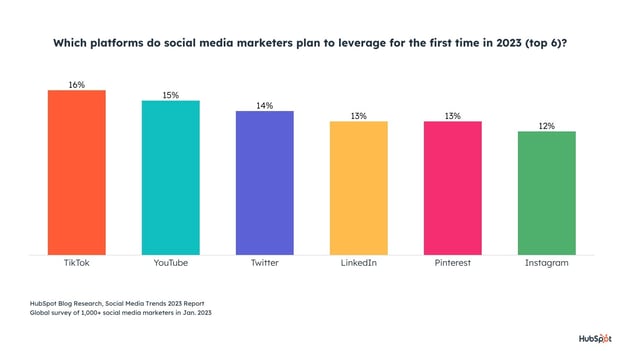
If you’re thinking of trying out a new social media platform, you might be curious about how to determine which ones are worth the investment. Social media marketers prioritize the potential for lead generation, audience reach, web traffic, and building an active community.
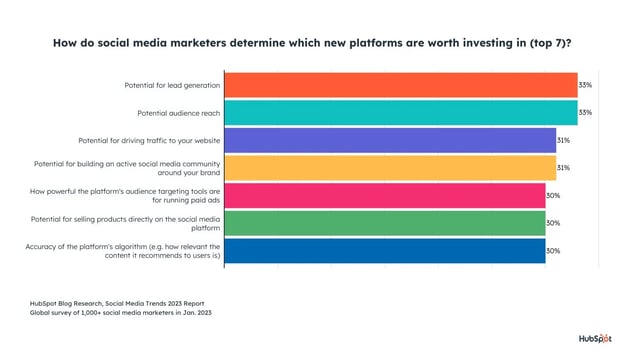
The platform’s audience targeting tools, social selling tools, and algorithm are also key considerations.
Next, let’s take a look at which formats will dominate social media in 2023.
COMING FEBRUARY 15] The State of Social Media in 2023: Click Here to Set a Google Calendar Reminder
Top Content Types Social Media Marketers Will Lean Into in 2023
7. Short-form Video Continues Its Takeover
Get ready to press record, because video is the most popular, highest ROI format when it comes to social media marketing, and it will see the most growth in 2023.
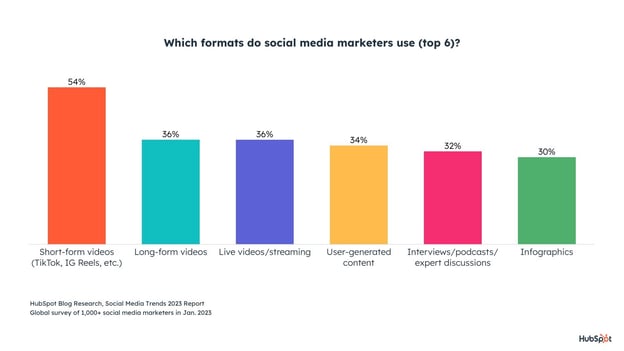
Short-form video will continue its winning streak as the highest ROI format, with long-form in 2nd place, though it isn’t close. Interviews and podcasts also offer high ROI, with bonus points if they have video to go with them. Live streaming and user-generated content are also highly effective.
Short-form video will see the most growth in 2023 by far, with 33% of social media marketers planning to invest more in it than any other format. 58% of those using it are also planning to increase their investment in 2023, while 32% will keep investing the same amount.
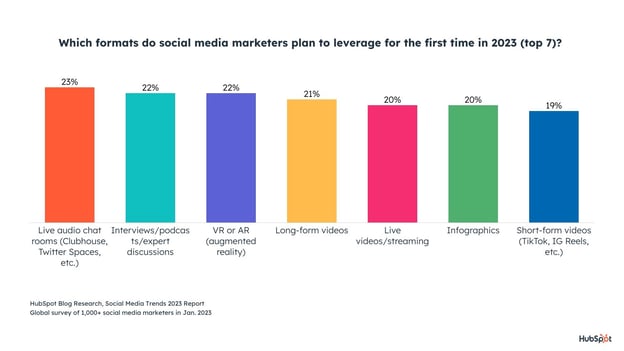
Other Top Social Media Content Formats
The top format gaining steam in 2023 is live audio chat rooms, with 23% of social media marketers planning to try it out this year. Interviews and/or podcasts, and VR/AR are also going to see some trial runs as marketers experiment on social media in 2023.
On the consumer side, short-form video is Gen Z and Millennials’ preferred format to learn about new products. 57% of Gen Z and 42% of Millennials prefer to learn about products and their features through short-form video over any other format.
Short-form is undeniably the format of the year, but what type of content should you be posting? Let’s take a look.
8. Funny, trendy, and relatable content will stand out.
Social media marketers post content non-stop; 20% post daily, 22% post a few times a day, and 34% do it several times a week.
But what kind of content are they posting? 45% post content that reflects their brand’s values, followed by relatable (42%), educational (39%), trendy (39%) and funny content (36%).
Of the formats they use, 66% of social media marketers say funny content is the most effective, followed by relatable content (63%) and trendy content (59%).
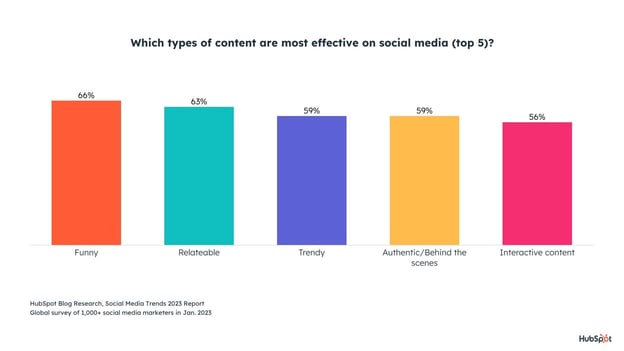
But don’t just take their word for it – when it comes to brands posting on social media, 49% of consumers say funny content is the most memorable, followed by relatable content at #2 (36%).
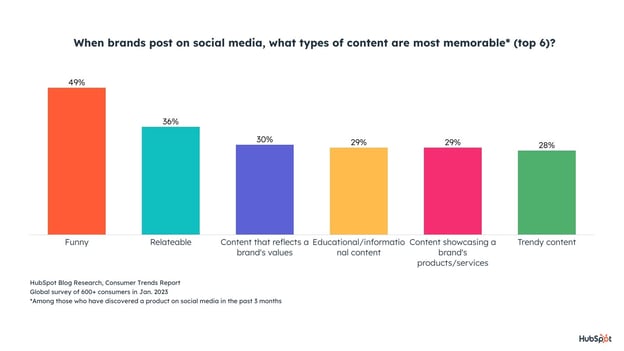
Relatable and trendy content also offer social media marketers the biggest ROI, and marketers will invest more in these content types in 2023. Unsurprisingly, this content type will grow significantly in 2023 as 26% of social media marketers plan to give it a try for the first time, the highest of any content type. Among those already using it, 49% plan to increase their investment and 43% keep investing the same amount.
Funny content will see the second-most investment of any content type in 2023 and 21% of social media marketers plan to use it for the first time next year. Among those already making funny content, 50% plan to increase their investment while 41% will keep it the same.
Social Media Challenges
9. Creating engaging content.
Each year, one of the top challenges social media marketers face involves creating engaging content. So, it’s no surprise that 17% of those we polled said it was their top hurdle.
And, it makes sense. In social media, content is vital for driving engagement, traffic, and conversions that boost your business. However, social media, its trends, and what people want to see on each platform change daily. It’s pretty tough to keep up.
In fact, our survey shows keeping up with these changes is a job in itself. Over 20% of social media marketers search for new or emerging trends every day.
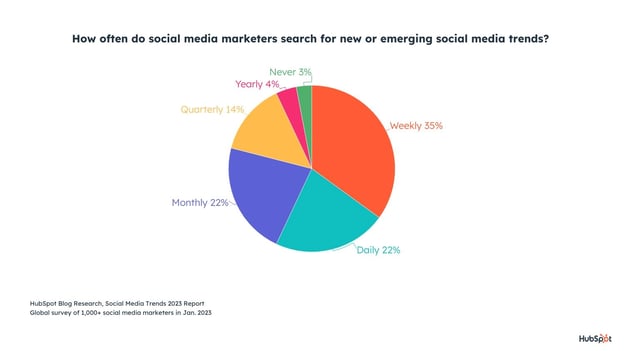
10. Re-sharing the same content across platforms won’t fly in 2023.
Once you do publish a piece of content that’s super engaging, you can’t just republish it on any other platform these days.
We get why you’d want to repurpose social content – making fresh posts isn’t easy, and with the average social media marketer juggling four platforms at once, re-posting is inevitable.
But, like any community, each platform has unique norms, and they don’t look fondly on brands going on blatant cross-posting sprees.
The good news is that you don’t have to make content from scratch. Instead, tailor it to the unique tone, aesthetic, and demographic of each social app.
48% of social media marketers do just that – sharing similar content across platforms with some tweaks. Another 34% make unique content from scratch for each platform, and just 17% continue to share the exact same content across platforms.
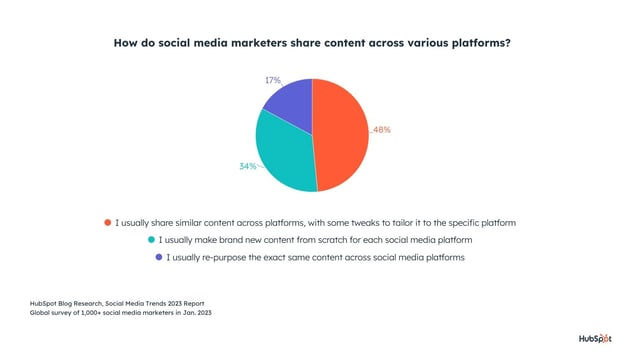
10. Turning engagements into leads.
Like all marketers, social media pros are always asking themselves, “How can my work benefit the bigger business?” And, one measurable way to justify business impact is by driving leads or conversions.
Yet, that’s still pretty hard. After all, most social media scrollers don’t just want to leave their feed to become a lead or a customer and come right back. To win them over, you’ll have to create content that energizes them beyond the point of simply commenting or clicking a reaction emoji. That’s why we absolutely aren’t shocked that 15% of social media marketers list lead generation as one of their top challenges.
Other Social Media Challenges
It’s no surprise that the top social media marketing challenges mostly mirror the goals we’ll discuss below. Creating engaging content tops the list, followed by reaching your target audience, gaining and keeping followers, and making content that generates leads.
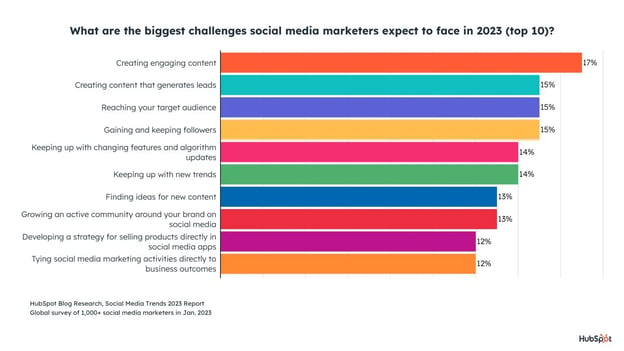
These challenges make sense – our research shows that many marketers are missing key information on their audience, from basic demographic info to the challenges they face and their hobbies. Having that information is key to making relevant, engaging content that resonates with your target audience.
Another set of challenges revolves around keeping up with the latest trends, social platform updates, and finding new ideas.
Top Social Media Marketing Goals
Social media marketers are laser-focused on their audience in 2023. Connecting with their community is their top goal, and raising brand awareness by growing their audience will also be a priority.
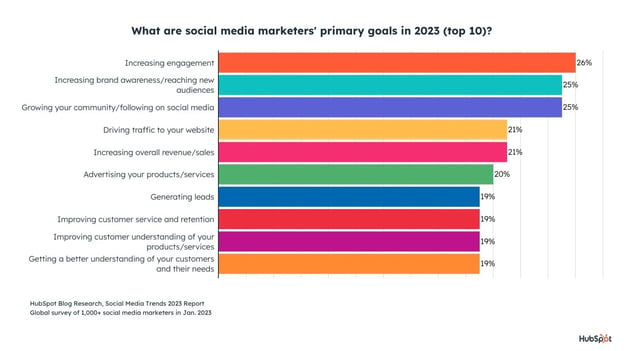
Despite the rise of in-app social shopping, driving traffic to an external website is still a top goal for social media marketers. But that may change drastically this year as platforms continue developing native shopping tools.
Another top goal is advertising their products or services, along with a focus on improving customers’ understanding of their offering.
20% of social media marketers also list improving customer service and retention as a key priority for 2023 – especially as consumers get more used to reaching out for customer service over DMs.
The Top Social Media Marketing Metrics
How are social media marketers tracking success? Let’s see what metrics they’re looking at when posting organic and paid content.
For both organic and paid content, web traffic, sales, lead generation, impressions/views, and engagement likes and comments are the top metrics. 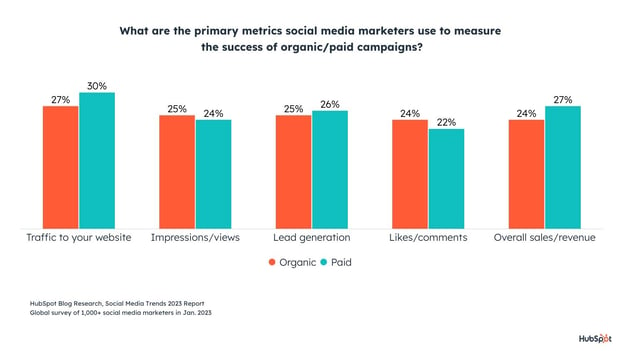
Unsurprisingly, when posting paid content marketers prioritize web traffic, sales, and leads, while views and engagement are slightly more important for organic content.
The Best Times to Post on Social Media
As a social media marketer, you likely want to be posting at the best times for peak engagement. So, while we had our social media survey participants, we got their thoughts on the best times to post across social media platforms in the U.S. specifically.
- Facebook: 9 AM to 12 AM
- YouTube: 3 PM to 6 PM
- Instagram: 12 PM to 6 PM
- TikTok: 3 PM to 9 PM
- Twitter: 9 AM to 3 PM
- LinkedIn: 9 AM to 3 PM
For tips on what other times to post or what to post during the times above, check out this social scheduling guide.
7 Social Media Predictions for 2023
Among those we surveyed:
- 87% say consumers will search for brands on social media more often than with search engines.
- 84% say social media will become consumers’ preferred channel for customer service.
- Over 80% say consumers will buy products from brands directly in social media apps more often than from a brand’s website/third-party websites.
- 90% say building an active online community is crucial to a successful social media strategy
- 88% say most brands will have an active social media community around their brand
- 87% say most brands will offer customer service through social media.
- 82% say most brands will sell products directly within social media apps.
What’s Next for Social Media Marketing?
Ultimately, it’s up to you and your company to determine and plan out your future success strategies! But, our data and insights are always here to help.
To get started in building, refining, or researching more opportunities for your social media strategy:
- Take our free social media certification course.
- Visit our State of Social Media Hub page where you’ll find more data, videos, and exclusive expert insights.
- Download the free report below for saveable PDF with key data and isnights.
{{slideInCta(‘5697308f-eba0-4046-b677-8fcec1c27dfb’)}
![]()


![Download Now: The 2023 State of Social Media Trends [Free Report]](https://no-cache.hubspot.com/cta/default/53/3dc1dfd9-2cb4-4498-8c57-19dbb5671820.png)
